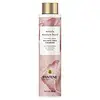Pantene Sulfate Free Shampoo with Rose Water Versus Tula Skincare Radiant Skin Brightening Serum Skin Tint Sunscreen SPF 30
What's inside
What's inside
 Key Ingredients
Key Ingredients

 Benefits
Benefits

 Concerns
Concerns

 Ingredients Side-by-side
Ingredients Side-by-side

Butyl Methoxydibenzoylmethane 3%
UV AbsorberEthylhexyl Salicylate 5%
UV AbsorberWater
Skin ConditioningC9-12 Alkane
SolventButyloctyl Salicylate
Skin ConditioningCaprylic/Capric Triglyceride
MaskingEthylhexyl Palmitate
EmollientTriethylhexanoin
MaskingPolyglyceryl-6 Polyhydroxystearate
EmulsifyingPolyglyceryl-6 Polyricinoleate
EmulsifyingIsododecane
EmollientSilica
AbrasiveButylene Glycol
HumectantDisteardimonium Hectorite
StabilisingTrimethylsiloxysilicate
EmollientVp/Eicosene Copolymer
Glycerin
HumectantArgania Spinosa Kernel Oil
EmollientTocopheryl Acetate
AntioxidantLactococcus Ferment Lysate
Skin ConditioningLactobacillus Ferment
Skin ConditioningLactobacillus
Skin ConditioningKappaphycus Alvarezii Extract
Skin ConditioningTetrahexyldecyl Ascorbate
AntioxidantNiacinamide
SmoothingSodium Hyaluronate
HumectantCeramide NP
Skin ConditioningPongamia Glabra Seed Oil
Skin ConditioningDunaliella Salina Extract
Skin ConditioningHaematococcus Pluvialis Extract
AntioxidantAcacia Seyal Gum Extract
HumectantCaesalpinia Spinosa Fruit Extract
Skin ProtectingAlpha-Glucan Oligosaccharide
CleansingBisabolol
MaskingBeta Vulgaris Root Extract
Skin ConditioningCystoseira Tamariscifolia Extract
Skin ConditioningInulin
Skin ConditioningLactic Acid
BufferingPolymnia Sonchifolia Root Juice
Skin ConditioningCurcuma Longa Root Extract
MaskingVp/Hexadecene Copolymer
Octyldodecyl Neopentanoate
EmollientSodium Chloride
MaskingMagnesium Sulfate
Boron Nitride
AbsorbentSorbitan Oleate
EmulsifyingPolyglycerin-6
HumectantOctyldodecanol
EmollientSafflower Oil/Palm Oil Aminopropanediol Esters
Skin ConditioningMica
Cosmetic ColorantHydrogenated Lecithin
EmulsifyingAscorbyl Palmitate
AntioxidantPentaerythrityl Tetra-Di-T-Butyl Hydroxyhydrocinnamate
AntioxidantDimethicone
EmollientTocopherol
AntioxidantMaltodextrin
AbsorbentEthylhexylglycerin
Skin ConditioningAluminum Hydroxide
EmollientCitric Acid
Buffering1,2-Hexanediol
Skin ConditioningCaprylyl Glycol
EmollientPhenoxyethanol
PreservativeSodium Benzoate
MaskingPotassium Sorbate
PreservativeCI 77891
Cosmetic ColorantCI 77492
Cosmetic ColorantCI 77491
Cosmetic ColorantCI 77499
Cosmetic ColorantButyl Methoxydibenzoylmethane 3%, Ethylhexyl Salicylate 5%, Water, C9-12 Alkane, Butyloctyl Salicylate, Caprylic/Capric Triglyceride, Ethylhexyl Palmitate, Triethylhexanoin, Polyglyceryl-6 Polyhydroxystearate, Polyglyceryl-6 Polyricinoleate, Isododecane, Silica, Butylene Glycol, Disteardimonium Hectorite, Trimethylsiloxysilicate, Vp/Eicosene Copolymer, Glycerin, Argania Spinosa Kernel Oil, Tocopheryl Acetate, Lactococcus Ferment Lysate, Lactobacillus Ferment, Lactobacillus, Kappaphycus Alvarezii Extract, Tetrahexyldecyl Ascorbate, Niacinamide, Sodium Hyaluronate, Ceramide NP, Pongamia Glabra Seed Oil, Dunaliella Salina Extract, Haematococcus Pluvialis Extract, Acacia Seyal Gum Extract, Caesalpinia Spinosa Fruit Extract, Alpha-Glucan Oligosaccharide, Bisabolol, Beta Vulgaris Root Extract, Cystoseira Tamariscifolia Extract, Inulin, Lactic Acid, Polymnia Sonchifolia Root Juice, Curcuma Longa Root Extract, Vp/Hexadecene Copolymer, Octyldodecyl Neopentanoate, Sodium Chloride, Magnesium Sulfate, Boron Nitride, Sorbitan Oleate, Polyglycerin-6, Octyldodecanol, Safflower Oil/Palm Oil Aminopropanediol Esters, Mica, Hydrogenated Lecithin, Ascorbyl Palmitate, Pentaerythrityl Tetra-Di-T-Butyl Hydroxyhydrocinnamate, Dimethicone, Tocopherol, Maltodextrin, Ethylhexylglycerin, Aluminum Hydroxide, Citric Acid, 1,2-Hexanediol, Caprylyl Glycol, Phenoxyethanol, Sodium Benzoate, Potassium Sorbate, CI 77891, CI 77492, CI 77491, CI 77499
 Reviews
Reviews

Ingredients Explained
These ingredients are found in both products.
Ingredients higher up in an ingredient list are typically present in a larger amount.
Citric Acid is an alpha hydroxy acid (AHA) naturally found in citrus fruits like oranges, lemons, and limes.
Like other AHAs, citric acid can exfoliate skin by breaking down the bonds that hold dead skin cells together. This helps reveal smoother and brighter skin underneath.
However, this exfoliating effect only happens at high concentrations (20%) which can be hard to find in cosmetic products.
Due to this, citric acid is usually included in small amounts as a pH adjuster. This helps keep products slightly more acidic and compatible with skin's natural pH.
In skincare formulas, citric acid can:
While it can provide some skin benefits, research shows lactic acid and glycolic acid are generally more effective and less irritating exfoliants.
Most citric acid used in skincare today is made by fermenting sugars (usually from molasses). This synthetic version is identical to the natural citrus form but easier to stabilize and use in formulations.
Read more about some other popular AHA's here:
Learn more about Citric AcidSodium Benzoate is a preservative. It's used in both cosmetic and food products to inhibit the growth of mold and bacteria. It is typically produced synthetically.
Both the US FDA and EU Health Committee have approved the use of sodium benzoate. In the US, levels of 0.1% (of the total product) are allowed.
Sodium benzoate works as a preservative by inhibiting the growth of bacteria inside of cells. It prevents the cell from fermenting a type of sugar using an enzyme called phosphofructokinase.
It is the salt of benzoic acid. Foods containing sodium benzoate include soda, salad dressings, condiments, fruit juices, wines, and snack foods.
Studies for using ascorbic acid and sodium benzoate in cosmetics are lacking, especially in skincare routines with multiple steps.
We always recommend speaking with a professional, such as a dermatologist, if you have any concerns.
Learn more about Sodium BenzoateWater. It's the most common cosmetic ingredient of all. You'll usually see it at the top of ingredient lists, meaning that it makes up the largest part of the product.
So why is it so popular? Water most often acts as a solvent - this means that it helps dissolve other ingredients into the formulation.
You'll also recognize water as that liquid we all need to stay alive. If you see this, drink a glass of water. Stay hydrated!
Learn more about Water